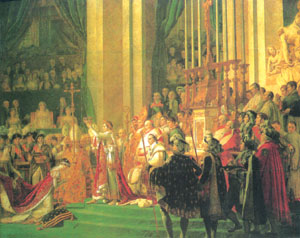How Beethoven destroyed Eroica - Symphony No. 3
Gwen Herat in Paris
|

CAUSE: The coronation of Napolean Bonaparte as Emperor that made
Beethoven angry and destroy Eroica dedicated to him.
|
MUSIC: Basically, all great and gifted persons whether they
are writers, poets, painters, dancers, or composers are very
highly-strung people, oozing with passion and given top tantrum while
many end up as homosexuals.
The irony is that it is confined only to men and not women who have
achieved greatness but still remain as very normal human beings. If you
care to study William Shakespeare, Oscar Wilde, Erik Braun, Rudolf
Nureyev Tchaikovsky etc. who had reached dizzy heights, they make an
endless list apart from the ‘modern’ world figures.
Separately, Ludwig Van Beethoven who was a very normal sensitive
composer whose wizardry on the strings awed and amazed the world in the
centuries after his death, also had his own share of obsession with
passion that prompted him to tear the scoresheets Eroica, Symphony No. 3
with such rage that he dented a hole in it. He tore it to bits and flung
it in the air.
However, it took almost ten years for Eroica to go public. The
manuscript of Eroica (Symphony No. 3) is in safe-keeping at Gesellschaft
der Musikfreunde in Vienna.
The incident was the result of his dedication to Eroica, Symphony No.
3 to Napolean whom he idolized with much expectancy to deliver what was
in his heart. Prelude to this incident, Beethoven premiered his First
Symphony in 1800, after composing Of First String Quarter.
This was followed by his immaculate score of Christ on the Mount of
Olives in 1803. Came April 7 of 1805 when his first public performance
of Eroica, Symphony No. 3 that was hailed as one of his great works and
the same year, Beethoven his Seventh and Eighth Symphonies and his last
violin Sonata No. 10. But Eroica, his spectacular composition made him
mad with rage for he found Napoleon whom he saw as embodying his ideals
of equality and freedom because the nine symphonies of Beethoven is the
pillars of western art.
The music which is genial and exhuberant on which he scored the
likeness of Eroica with snapping of musical chains embodying the leaping
chord which opens the work, something remarkable had been unleashed
underlying the heroism, that idealised Beethoven who was a sworn
republican originally dedicated to the work of Napolean Bonaparte.
But he was bitterly disappointed when Napolean took the title of
Emperor with all the trappings that accompanied the crowning. It
displayed Napoleon to be every bit as bent on self-esteem and vanity.
Beethoven reacted to his autocratic aristocracy by angrily destroying
Eroica.
This spectacular score with its elevation of the first movement of
the Eroica is followed by a Funeral March that seems hewn out of granite
as its apex undergoing the development of awesome intensity and grandeur
and the symphony concludes with a set of variations (which I discovered
later) on a theme Beethoven wrote for a ballet based on the legend of
Prometheus. (That was my curiosity to research on this particular
score).
Beethoven’s Fourth Symphony was a sensation that prompted Robert
Schumann to describe it to a slender Grecian beauty between two Nordic
Giants. Naturally, the giants were the Third and Fifth symphonies.
While writing the Fourth Symphony, the composer engaged himself to
scoring yet another symphony which he had put aside to complete his
exotic Eroica that had a tragic end and forced to be destroyed.
Beethoven was different. He freed himself to score, breaking away
from the shackles that bound many composers to abide by. While Masters
like Mozart, Bach and Hayden contained surprises in their inevitability
in their music, Beethoven became unpredictable, sometimes lacking
originality and imagination because he wanted to express that he never
desired to be ruled by conventions.
This paid him off as he scored one to another and ended as the most
amazing Romantic composer, adored by the whole world. His music bestrode
two centuries and many eras and developed into such heights that the
stage was set for composers such as Bach, Haydn, Berlios, Wagner etc to
perform during the 19th century.
Ludwig Van Beethoven was born in Bonn and died in Vienna on 26 March
1827 after a spectacular and electrifying career.
Some of his popular scores apart from his mysterious Eroica, are:
Symphony No. 5 in C minor, String Quartert in B flat major, Symphony
No. 9 in D minor, Sonata No. 8 in C minor, Symphony No. 6 in F major,
Moonlight-Sonata No. 14 in C sharp major, Leonare Overture, Symphony No.
8 in F major, Piano Concerto No. 5 in E flat major, Symphony No. 7 in A
major, Piano Sonata No. 23 in F minor - Appassionata and Symphony No. 9
in D major - ODE to Joy. |

